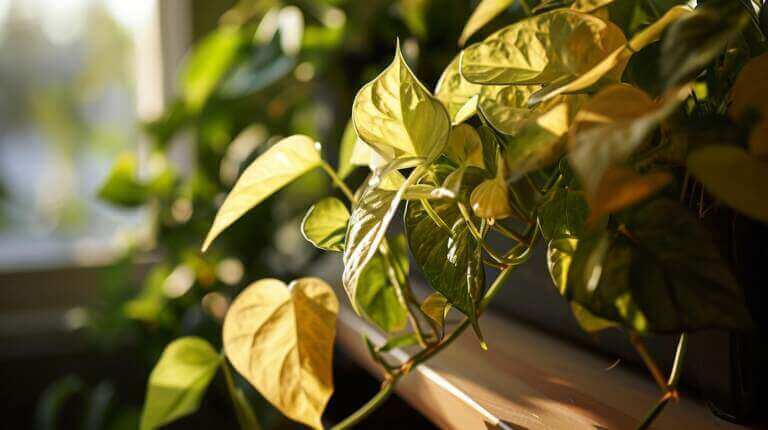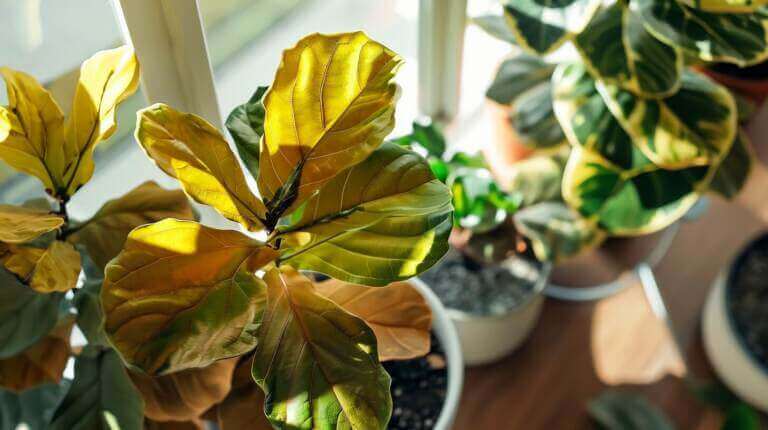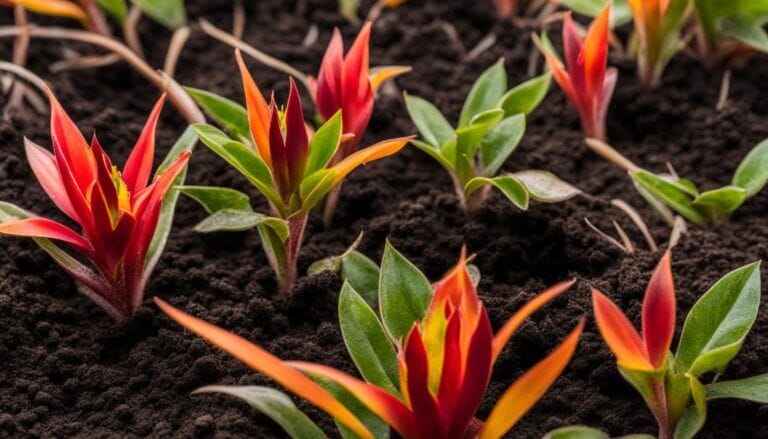The croton plant, scientifically known as Codiaeum variegatum, offers a wide range of unique hybrids and cultivars with striking foliage. There are over 700 recorded varieties of crotons, each with its own genetic variability and color patterns. These plants have been cultivated and hybridized by horticulturists and plantsmen for centuries, resulting in a diverse collection of croton hybrids and cultivars to choose from.
Key Takeaways:
- Crotons, scientifically known as Codiaeum variegatum, offer a wide range of unique hybrids and cultivars.
- There are over 700 recorded varieties of crotons, each with its own genetic variability and color patterns.
- Croton hybrids and cultivars are known for their beautiful foliage and vibrant colors.
- They can be grown as indoor or outdoor ornamental plants and require bright indirect light and high humidity levels.
- Popular croton hybrid varieties include ‘Petra,’ ‘Zanzibar,’ ‘Gold Dust,’ ‘Gold Star,’ and ‘Red Iceton.’
The Beauty of Croton Hybrids and Cultivars
Croton hybrids and cultivars are known for their stunning foliage and vibrant colors. These plants, scientifically known as Codiaeum variegatum, offer a wide range of options for plant enthusiasts. With their colorful leaves and unique variegation patterns, croton hybrids and cultivars add a touch of beauty and elegance to any indoor or outdoor space.
The foliage of croton hybrids can display an array of shades, including green, red, yellow, orange, and purple. These colors often come together in striking combinations, creating a visually captivating display. The leaves may also feature intricate patterns and markings, enhancing their overall appeal.
Whether you’re a fan of bold and vibrant colors or prefer more subtle hues, croton hybrids and cultivars offer something for everyone. Their foliage can serve as a focal point in garden beds, borders, or planters, making them popular choices among plant enthusiasts looking to add a splash of color to their spaces. Additionally, their striking appearance makes them excellent choices for adding visual interest to indoor settings such as living rooms, offices, or lobbies.
Table: Popular Croton Hybrids and Their Characteristics
| Croton Hybrid | Leaf Color | Leaf Shape | Growth Habit |
|---|---|---|---|
| Petra | Green, Red, Yellow | Oval | Upright |
| Zanzibar | Green, Orange, Yellow | Long and Narrow | Arching |
| Gold Dust | Green, Yellow | Wavy | Compact |
| Gold Star | Green, Yellow | Pointed | Columnar |
| Red Iceton | Green, Red | Curved | Vase-shaped |
The table above showcases some popular croton hybrids and their characteristics. These varieties offer a wide range of leaf colors, shapes, and growth habits, allowing collectors to find the perfect addition to their plant collection.
Growing and Care Tips for Croton Hybrids
When it comes to growing croton hybrids, providing them with the right conditions is crucial for their optimal growth and vibrant foliage. These stunning plants can be grown both indoors as houseplants and outdoors in warm climates, adding a touch of exotic beauty to any space.
Croton hybrids thrive in bright indirect light, so it’s important to place them near a window or in a well-lit area. They also require high humidity levels, so misting the leaves regularly or placing them on a tray filled with water and pebbles can help create a humid environment. As for watering, it’s essential to keep the soil consistently moist but not overly saturated to avoid root rot.
Proper soil drainage is also key for the healthy growth of croton hybrids. Using well-draining soil or adding perlite to the potting mix can prevent waterlogging and ensure the roots receive enough oxygen. Fertilizing the plants every 2-4 weeks during the growing season with a balanced fertilizer will help maintain their vibrant foliage.
When it comes to outdoor cultivation, croton hybrids are well-suited for gardens in warm climates. However, it’s important to protect them from frost or extreme temperature fluctuations, as they are sensitive to cold. Additionally, regular pruning can help shape the plants and encourage new growth.
Tips for Growing Croton Hybrids:
- Provide bright indirect light, either near a window or with artificial plant lights.
- Maintain high humidity levels, through misting or using a humidifier.
- Water regularly, keeping the soil moist but not waterlogged.
- Ensure proper soil drainage with well-draining soil or adding perlite.
- Fertilize every 2-4 weeks with a balanced fertilizer during the growing season.
- Protect from frost and extreme temperature fluctuations in outdoor gardens.
- Regularly prune to shape the plants and encourage new growth.
By following these care tips, you can enjoy the beauty of croton hybrids and ensure their long-term health and vitality. Whether you choose to grow them indoors or outdoors, these plants will add a stunning display of colorful foliage to your space.
Popular Croton Hybrid Varieties to Collect
If you’re a foliage plant enthusiast looking to expand your collection, popular croton hybrids are a must-have addition. These stunning plants are known for their colorful leaves and unique growth habits, making them a favorite among collectors. Here are some popular croton hybrid varieties that you’ll definitely want to add to your collection:
“Petra” – This croton hybrid features broad, glossy leaves with vibrant shades of red, orange, and yellow. Its eye-catching colors make it a statement piece in any indoor or outdoor setting.
“Zanzibar” – Known for its distinctive zigzag pattern on the leaves, the Zanzibar croton hybrid adds a touch of whimsy to any collection. Its foliage combines shades of green, yellow, and red, creating a visually striking display.
“Gold Dust” – True to its name, the Gold Dust croton hybrid boasts leaves speckled with golden-yellow spots. This variety adds a touch of brightness and warmth to any space, making it a popular choice among collectors.
“Gold Star” – With its slender, lance-shaped leaves and a blend of yellow and green colors, the Gold Star croton hybrid is a true showstopper. It adds a touch of elegance and sophistication to any collection.
“Red Iceton” – This croton hybrid variety showcases deep red and burgundy shades throughout its leaves. Its rich colors add depth and drama to any collection, making it a highly sought-after variety for collectors.
The popularity of these croton hybrid varieties stems from their vibrant colors, unique leaf shapes, and overall visual appeal. Adding them to your collection will not only enhance the diversity of your foliage plants but also create a striking display that is sure to impress.
Next in this article, we will explore rare croton hybrids and cultivars that are highly prized by collectors.
Rare Croton Hybrids and Cultivars
In addition to popular croton hybrids, there are also rare varieties that are highly prized by collectors. These rare croton hybrids and cultivars may have unique leaf shapes, color combinations, or growth habits that make them stand out. Collectors often go to great lengths to find and acquire these rare crotons to add to their collection.
One example of a rare croton hybrid is the ‘Royal Flush,’ which features large, glossy leaves with a stunning mix of red, pink, and purple hues. Another rare cultivar is the ‘Dreadlocks,’ known for its long, twisted leaves that resemble the strands of hair it is named after. These rare croton hybrids can be a captivating addition to any collection and are sure to be conversation starters.
“Rare croton hybrids and cultivars offer a unique opportunity for collectors to own truly one-of-a-kind plants. The rarity of these hybrids adds to their allure, making them highly sought after in the plant enthusiast community.”
When searching for rare croton hybrids, it is essential to connect with specialized nurseries and online plant communities. These sources often have access to limited quantities of rare crotons and can provide guidance on their care and cultivation. Some rare croton hybrids may require specific growing conditions or expert care, so it is important to research and understand the unique needs of each variety.
| Rare Croton Hybrid | Leaf Description |
|---|---|
| ‘Royal Flush’ | Large, glossy leaves with a mix of red, pink, and purple hues |
| ‘Dreadlocks’ | Long, twisted leaves resembling strands of hair |
| ‘Velvet Elvis’ | Dark green leaves with a velvety texture and prominent veins |
| ‘Phantom’ | Unique purple and green variegated leaves |
Collecting rare croton hybrids can be an exciting journey for plant enthusiasts. The thrill of discovering and acquiring these unique plants adds a sense of adventure to the hobby. By expanding your collection with rare croton cultivars, you can create a visually stunning display of foliage and showcase the diversity and beauty of these exceptional hybrids.
References:
- “Rare Croton Hybrids: Unique Additions to Your Plant Collection.” Plant Enthusiast Magazine.
- “Discovering the Rare: A Guide to Collecting Croton Cultivars.” The Collector’s Garden Blog.
Propagation and Care Tips for Croton Hybrids
Propagating croton hybrids is a rewarding way to expand your collection and share these unique plants with others. There are several methods you can use to propagate croton hybrids, including stem cuttings and air layering.
When propagating croton hybrids from stem cuttings, select a healthy stem with multiple nodes and remove any leaves from the bottom half of the cutting. Dip the cut end in rooting hormone and place it in a well-draining potting mix. Keep the cutting in a warm and humid environment, misting it regularly to maintain moisture levels. After a few weeks, the cutting should develop roots, and you can transfer it to a larger pot.
Air layering is another effective method for propagating croton hybrids. Select a healthy stem and make a small upward cut on the stem about halfway through. Apply rooting hormone to the cut area and wrap it in moist sphagnum moss. Cover the moss with plastic wrap to create a humid environment and secure it in place with ties. After a few weeks, roots should form at the cut area, and you can remove the rooted section and pot it up.
Plant Care for Croton Hybrids
Croton hybrids require specific care to thrive and maintain their vibrant foliage. Here are some essential care tips for these beautiful plants:
- Light: Place your croton hybrid in bright indirect light. Avoid direct sunlight, as it can scorch the leaves.
- Watering: Water your croton hybrid regularly, keeping the soil evenly moist. Be careful not to overwater, as this can lead to root rot.
- Humidity: Croton hybrids prefer high humidity levels. You can increase humidity by placing the plant on a tray filled with pebbles and water.
- Fertilization: Feed your croton hybrid with a balanced liquid fertilizer every 2-4 weeks during the growing season. This will provide the necessary nutrients for healthy growth.
- Pest Control: Keep an eye out for common pests such as spider mites and mealybugs. If you notice any signs of infestation, treat the plant with an appropriate insecticide or use natural pest control methods.
Tips for Collecting and Caring for Croton Hybrids
Collecting and caring for croton hybrids can be an exciting and fulfilling hobby. These unique plants offer a wide range of colors, patterns, and leaf shapes, making them a popular choice for both indoor and outdoor gardens. Whether you’re a seasoned collector or just starting out, here are some tips to help you build a stunning croton hybrid collection and keep your plants thriving.
Collecting Croton Hybrids
- Choose varieties that appeal to your personal taste and preferences. Look for colors and leaf patterns that catch your eye, and consider the overall size and shape of the plant.
- Research reputable nurseries, plant collectors, and online plant shops to find a wide selection of croton hybrids. Take the time to read reviews and check the authenticity of the plants.
- Join online forums and plant enthusiast groups to connect with other collectors and learn more about rare and sought-after croton hybrids.
- Consider attending plant fairs and horticultural events where you can find a diverse range of croton hybrids and get expert advice from growers.
Caring for Croton Hybrids
Proper care is essential to keep your croton hybrids healthy and thriving. Here are some important care tips to follow:
- Light: Croton hybrids thrive in bright, indirect light. Place them near a window with filtered sunlight or provide them with artificial grow lights.
- Watering: Water your croton hybrids thoroughly, allowing the soil to dry slightly between waterings. Avoid overwatering, as it can lead to root rot.
- Humidity: Croton hybrids prefer high humidity levels. You can increase humidity by placing a tray of water near the plants or using a humidifier.
- Temperature: Keep your croton hybrids in a warm environment, as they prefer temperatures between 60-85°F (15-29°C).
- Fertilization: Feed your croton hybrids with a balanced, water-soluble fertilizer every 2-4 weeks during the growing season to promote healthy growth and vibrant foliage.
- Pest Control: Keep an eye out for common pests such as spider mites and mealybugs. If you notice any signs of infestation, treat your plants with an appropriate insecticide.
By following these tips, you can create a stunning collection of croton hybrids and ensure they flourish in your care. Enjoy the beauty and diversity that these plants have to offer!
Where to Find and Purchase Croton Hybrids and Cultivars
If you are looking to add unique croton hybrids and cultivars to your collection, there are several places where you can find and purchase these beautiful plants. Nurseries are a great place to start your search. Many nurseries specialize in offering a wide variety of croton hybrids, allowing you to browse and choose the ones that catch your eye. Make sure to inquire about the quality and authenticity of the plants before making a purchase.
Another option is to connect with plant collectors. These dedicated enthusiasts often have rare and hard-to-find croton hybrids in their collections. They may be willing to share cuttings or sell established plants. Attending plant swaps, local plant society meetings, or online plant forums can help you connect with fellow collectors who have croton hybrids for sale.
If you prefer the convenience of online shopping, there are several reputable online plant shops that offer a wide selection of croton hybrids and cultivars. When purchasing plants online, it is important to research the seller and read reviews from other customers to ensure a positive experience. Look for online shops that specialize in tropical plants or have a dedicated section for crotons.
Whether you choose to visit nurseries, connect with plant collectors, or shop online, there are plenty of options available to find and purchase croton hybrids and cultivars. Take your time to explore different sources and find the varieties that speak to you. With a little patience and research, you can build a beautiful collection of croton plants that will bring joy and color to your indoor or outdoor space.
FAQ
How many varieties of croton hybrids are there?
There are over 700 recorded varieties of crotons.
What are the popular croton hybrid varieties?
Some popular croton hybrid varieties include ‘Petra,’ ‘Zanzibar,’ ‘Gold Dust,’ ‘Gold Star,’ and ‘Red Iceton.’
How do I grow croton hybrids?
Croton hybrids prefer bright indirect light, high humidity levels, and regular watering. They can be grown indoors as houseplants or outdoors in warm climates.
How do I propagate croton hybrids?
Croton hybrids can be propagated through stem cuttings and air layering.
What care do croton hybrids require?
Croton hybrids require regular watering, fertilization, and protection from pests such as spider mites and mealybugs.
Where can I find and purchase croton hybrids?
Croton hybrids can be found and purchased from nurseries, plant collectors, and online plant shops.







